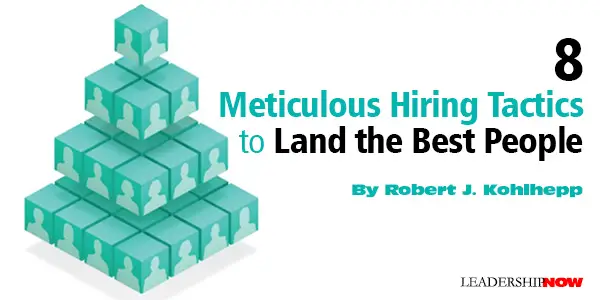 |
 |
10.20.21

8 Meticulous Hiring Tactics to Land the Best People
YOUR organization’s success comes down to who you hire. Just as great coaches don’t win many games without great players, great managers aren’t successful without the right people on their team. Finding, hiring, and developing great performers is the most important part of every manager’s job. One of the primary reasons for turnover in any organization is that the person who leaves or gets fired shouldn’t have been hired in the first place. A very structured process is essential for hiring the right people who are not only qualified to do the job but are also compatible with your organization. A meticulous process may require extra time on the front end but will save enormous time, energy, and money on the back end. Use these tactics to ensure success in your hiring process: 1. Conduct multiple interviews – When filling a position, conduct multiple interviews with each candidate, and recruit staff members to take part in the separate interviews. Following the interviews, bring together all the interviewers to discuss the candidate. You would be surprised how often a candidate answers the same question with a different answer. Look for unanimous consensus from all the people who participated in the interviews. 2. Account for “must-haves” and “preferreds” – For each job, establish “must-haves” and “preferreds.” A must-have is an absolute requirement on which you are unwilling to compromise. A preferred is a bonus attribute of a candidate. For example, an attorney who is licensed to practice in your state is a must-have, but a preferred qualification might be that he or she is licensed in adjoining states. 3. Examine past behavior – In interviews, the focus is on learning about past behavior because it often predicts future behavior. To better assess whether a job applicant might be a good fit, examine how the applicant behaved in the past. That’s not to say that people can’t change, but, in general, most people will continue to approach situations as they have in the past. To get reliable answers, ask situational questions. Examples could be: “What’s the most difficult decision you’ve ever made?” followed by “Tell me about that decision.” Or, “Have you ever fired anyone?” followed by “Tell me about the circumstances.” The goal is to understand how each candidate approaches or has approached situations and may act the next time a similar situation arises. 4. Check references – Rather than delegating the responsibility, the hiring manager should conduct the reference checks. Further, the hiring manager should make it a point to contact the former bosses from the candidate’s two most recent jobs. A boss can provide specific information about the candidate. Always ask a previous boss: “What areas did you ask the candidate to improve on in the most recent performance review?” You’d be surprised how often answers from the boss differ from those of the candidate in the interview. Reference checking is very important because the former bosses may provide insights that your interviews with the candidate won’t reveal. 5. Ask stress questions – Stress questions are those that test an applicant’s ability to perform under pressure. They require the candidate to react spontaneously to a stressful situation. Some examples of stress questions include: “How would you handle a customer who has verbally insulted you?” or “Why should I hire you?” or “How would you rate your performance in your previous role?” 6. Define the answers you’re looking for – As a good trial lawyer would tell you, “Don’t ever ask a question for which you don’t know the answer.” Similarly, you should always have a good idea of what constitutes a good answer to the questions you ask in an interview. Probe into any answers that you find either cursory or confusing. 7. Determine cultural compatibility – Every organization has its own culture. You know what it’s like to work at your organization and the kind of people who will fit in well. It’s important to ask questions that can reveal the potential compatibility of the candidate with the corporate culture. Specific questions could include: “How did you feel about your customers in previous jobs?” or “How did you feel about the people you worked with?” or “Tell me about your intensity in performing your job.” 8. Eliminate lukewarm candidates – From time to time, you may think you’re hiring the perfect candidate but later discover that you were wrong. But if your impression of a candidate is only lukewarm, you should refrain from hiring that person. Organizations hire lukewarm candidates because the hiring process is time-consuming and difficult, and they don’t wish to prolong it if no exceptional applicant surfaces. But making do with a mediocre candidate never works. You will be wrong every time. Hiring the right people is critical for your organization’s success. Use this structured, meticulous process to ensure that you hire well.  
Posted by Michael McKinney at 03:53 PM
|
BUILD YOUR KNOWLEDGE
 

How to Do Your Start-Up Right STRAIGHT TALK FOR START-UPS 
Grow Your Leadership Skills NEW AND UPCOMING LEADERSHIP BOOKS 
Leadership Minute BITE-SIZE CONCEPTS YOU CAN CHEW ON 
Classic Leadership Books BOOKS TO READ BEFORE YOU LEAD |